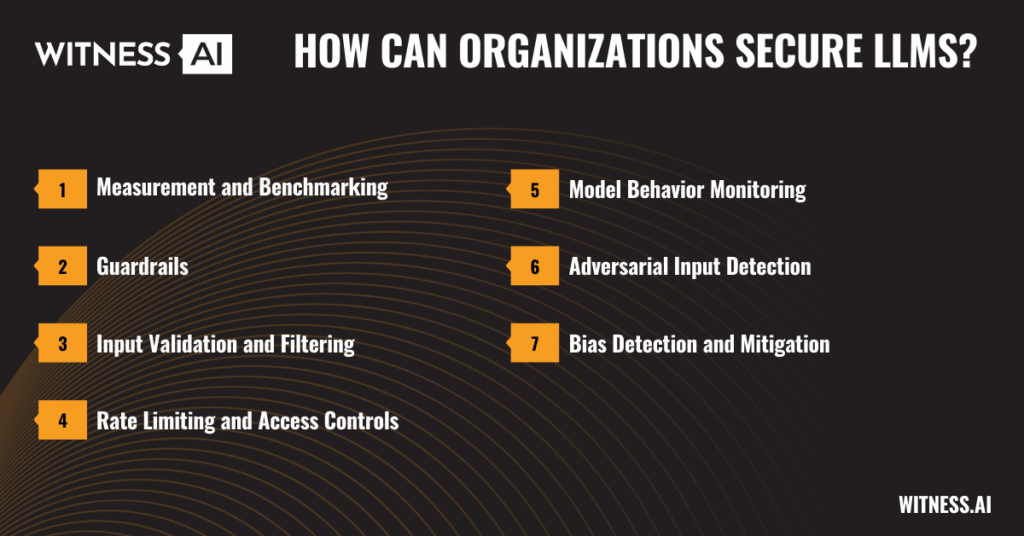What is LLM Security?
In the context of cybersecurity, LLM security refers to the set of practices, technologies, and policies used to protect large language models (LLMs) from vulnerabilities, misuse, and attacks. As LLMs such as GPT, Claude, and others are integrated into AI systems across industries, ensuring the security of their inputs, outputs, underlying training data, and model behaviors becomes essential to prevent security breaches, misinformation, and legal liabilities.
What are Large Language Models (LLMs)?
Large Language Models are advanced machine learning algorithms trained on vast datasets to understand, generate, and manipulate human language. Models like ChatGPT and other generative AI systems rely on deep neural networks, often using architectures like transformers, to predict and produce coherent language.
These models are used in various LLM applications including:
- Virtual assistants and chatbots
- Code generation
- Customer support automation
- Content creation
- Legal and healthcare support tools
Due to their versatility and ability to generalize across use cases, LLMs pose an expanding attack surface in modern enterprise environments.
Importance of Security in LLM Usage
Data Breaches
LLMs can unintentionally memorize and regurgitate sensitive data from their training corpus, risking exposure of intellectual property, personal data, or authentication credentials.
Model Exploitation
Attackers can manipulate LLMs through prompt injection attacks or exploit unauthorized access to APIs or internal tools, affecting their functionality and bypassing security safeguards.
Misinformation
Improperly validated LLM outputs can propagate misinformation, especially in high-stakes areas like healthcare, finance, or law, undermining decision-making.
Ethical and Legal Risks
Use of open-source or proprietary models without adequate vetting raises concerns around data privacy, compliance, and ethical AI practices, particularly with training data containing biased or copyrighted materials.
Top LLM Security Threats
1. Prompt Injection
Attackers craft malicious inputs that override instructions or trigger unintended behavior. These indirect prompt injection techniques can manipulate downstream actions, especially when models are connected to plugins, APIs, or other systems.
2. Data Leakage
LLMs may expose sensitive information from training datasets or prior user interactions, leading to data privacy violations or security breaches.
3. Insecure Third-Party Integrations
Connecting LLMs to unvetted APIs, plugins, or data sources introduces supply chain vulnerabilities, especially when output handling is not properly sanitized.
4. Model Theft and Reverse Engineering
Adversaries may attempt to steal or reverse-engineer a proprietary LLM model, gaining access to training techniques or valuable datasets.
5. Malicious Output Generation
Without proper output validation, models can produce harmful or misleading content, including phishing emails, false medical advice, or even code execution instructions leading to XSS or denial of service.
6. Jailbreaking and Safety Filter Evasion
Users can employ sophisticated jailbreak prompts to bypass safety filters, enabling access to harmful or restricted outputs.
7. Inadequate Access Controls
Lack of role-based permissions or authentication mechanisms can lead to unauthorized access and potential misuse of LLMs.
8. Training Data Poisoning
Malicious actors can insert harmful patterns into public or enterprise data sources used for fine-tuning, corrupting model behavior over time.
9. Overreliance Without Validation
Blindly trusting LLM outputs without human or algorithmic validation can lead to the spread of inaccurate, biased, or offensive content.
10. Regulatory and Compliance Violations
Failure to align LLM practices with laws such as GDPR, HIPAA, or data protection regulations can expose organizations to legal penalties.
Who Is Responsible for LLM Security?
LLM security is a shared responsibility across the AI ecosystem:
- Model Providers (e.g., OpenAI, Anthropic) must ensure secure training data sourcing, model alignment, and safety filters.
- Enterprise Users must implement application security, access controls, and continuous monitoring.
- IT and Security Teams need to enforce cybersecurity best practices and conduct regular audits.
- Developers must implement input sanitization, validation, and ethical usage guidelines.

How Can Organizations Secure LLMs?
1. Measurement and Benchmarking
Establish and track performance baselines across security posture, output quality, bias, and compliance to detect anomalies.
2. Guardrails
Implement safeguards such as keyword filters, output constraints, and contextual boundaries to guide model behavior.
3. Input Validation and Filtering
Use input validation and sanitization to detect malicious inputs, such as embedded commands or misleading prompts.
4. Rate Limiting and Access Controls
Apply rate limits and role-based access controls to prevent abuse and unauthorized access to LLM endpoints.
5. Model Behavior Monitoring
Continuously monitor LLM outputs in real-time to identify misuse patterns, insecure output handling, or drift in performance.
6. Adversarial Input Detection
Deploy techniques such as red teaming, automated stress testing, and embedding similarity checks to catch prompt manipulation.
7. Bias Detection and Mitigation
Evaluate LLMs for algorithmic bias by simulating real-world queries and fine-tune models to reduce security risks related to unfair or offensive content.
Conclusion
As generative AI continues to transform how businesses operate, the importance of LLM security cannot be overstated. From prompt injection attacks to training data poisoning, the threats to large language models are complex and evolving. Organizations must implement layered security measures, combining access controls, output validation, monitoring, and compliance safeguards to protect against misuse, maintain trust, and ensure safe deployment across llm applications.
About WitnessAI
WitnessAI enables safe and effective adoption of enterprise AI, through security and governance guardrails for public and private LLMs. The WitnessAI Secure AI Enablement Platform provides visibility of employee AI use, control of that use via AI-oriented policy, and protection of that use via data and topic security. Learn more at witness.ai.
